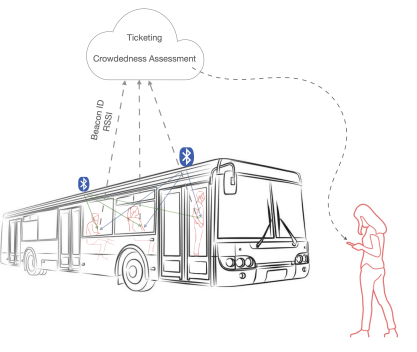Some of the first uses of beacons was on buses. For example, in 2015 in London, 500 buses sent targeted in-app messages to passengers. It didn’t work, Proxama ceased to be in business and thankfully the use of beacons for spamming went away. Today, the use of beacons has matured as has their use on buses.
There’s a useful presentation by Texas A&M Transportation Institute and Houston METRO on Bus Stop Beacons: Transit Wayfinding for People with Visual Impairments (pdf). They classify accessibility challenges as locating stops, knowing which routes serve stops, obtaining real-time information and boarding the vehicle. They conclude that multiple location sources, using Bluetooth with GPS, work better than a single source alone. Also, sound shouldn’t be the only way riders receive information from an app because noisy environments make listening difficult. Vibrations can be used to provide additional notifications.

There are insights from Connecthings/CTS in Strasbourg on helping the blind catch the right bus. There’s also guidance in In–Vehicle Positioning for Public Transit Using BLE Beacons that shows locating a passenger to at least 1 meter across the length of the bus vehicle is possible using Bluetooth beacons. This can be used to assess crowding.

The current state of the art is using beacons with ticketless payment and automatic boarding and un-boarding detection. The pioneer in this area is one of our consultancy clients, UrbanThings, who has an article on Increase ridership through mobile ticketing and case studies.
Another one of our customers, Lothian buses, uses beacons to aid accessibility:
Next Stop Announcements: when on a bus, the customer can select which bus route they are on and the app will announce the name of the next stop as the bus approaches (with buses fitted with Bluetooth beacons, the customer doesn’t even need to select which bus route they are on – the app knows automatically)
Read about Beacons in Transportation